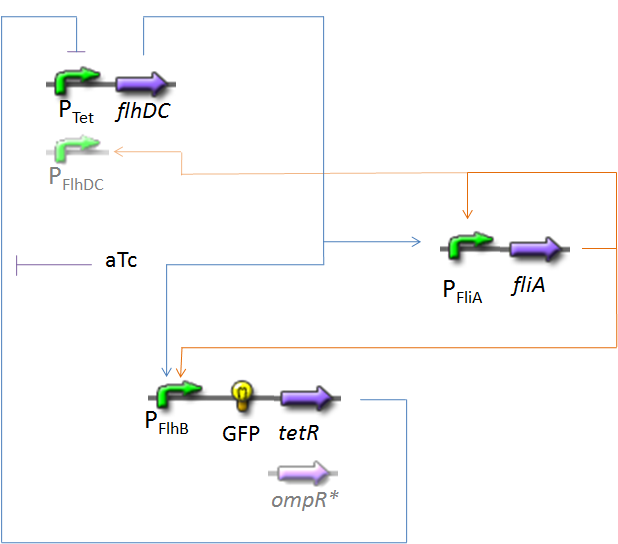Team:Paris/Modeling/Oscillations
From 2008.igem.org
(→Oscillations) |
(→Resulting Equations) |
||
| Line 25: | Line 25: | ||
==Resulting Equations== | ==Resulting Equations== | ||
| + | First, we introduce here what we assume to be in our model '''the involved chemical reactions'''. They are written in '''black''', regards to the equations that concerns both of the [[Team:Paris/Modeling/Oscillations#The_Circuit|alternatives]]. Moreover, and it is the case for the other colors, the reactions that are specific to the ''Ptet''-circuit are written lighter, and those specific to the ''PflhDC''-circuit are even lighter. | ||
| + | Then, the blue and green equations are those implemented in our [[Team:Paris/Modeling/Programs|simulation programs]]. | ||
| + | |||
| + | The '''blue''' ones correspond to the reactions of '''complexation''', and the '''red''' ones just below are the Hill functions that are their consequences if their stady-state are immediatly reached (see [[Team:Paris/Modeling/Oscillations#Biochemical_Assumptions|Biochemical Assumptions]]). However, we will surely use whole complexations equations in our programs, and the hypothesis of Hill functions will help us only for the [[Team:Paris/Modeling#Estimation_of_parameters|estimations of parameters]]. | ||
| + | |||
| + | The '''green''' ones correspond to the reaction of '''production''' of proteins. | ||
<html><iframe width="935" height="600" src="https://static.igem.org/mediawiki/2008/0/0e/Equa_Oscill.pdf" frameborder="0"></iframe></html> | <html><iframe width="935" height="600" src="https://static.igem.org/mediawiki/2008/0/0e/Equa_Oscill.pdf" frameborder="0"></iframe></html> | ||
|}<br style="clear:both" /> | |}<br style="clear:both" /> | ||
Revision as of 17:10, 1 August 2008
OscillationsThe CircuitWe just keep here the following circuit, constituing the Oscillations. We have two alternatives for the promoter before flhDC : Ptet or PflhDC. These two alternatives are both studied in what follows.
Biochemical AssumptionsWe do not take into acount the phenomenon of translation : we consider the transduction as leading directly to the protein. We assume that the expression rate of an inducible promoter is proportionnal to the number of created complexes promoter-inducer. In the same way, a repressible promoter has got a basal expression, and its expression is proportionnal to the number of free promoters. Then, in order to consider theses complexes and free promoters, we just consider the complexation reaction between the transcription factor and the promoter. If we consider that the steady-states of these equations are reached much quickly than the proteins are produced, that leads to promoter's expressions well described by Hill function. We use that property to get (see estimations of parameters) different constants involved in the equations below, but we will simulate the complexation reactions in our implementation, too. Endly, we simulate the creation of AHL that leads to the negative feed-back, but we still keep the intra cellular observation scale. We just add the hypothesis that all cells follow this determined behaviour, at the same speed, so that the concentration inside and outside the cell are always the same. Resulting EquationsFirst, we introduce here what we assume to be in our model the involved chemical reactions. They are written in black, regards to the equations that concerns both of the alternatives. Moreover, and it is the case for the other colors, the reactions that are specific to the Ptet-circuit are written lighter, and those specific to the PflhDC-circuit are even lighter. Then, the blue and green equations are those implemented in our simulation programs. The blue ones correspond to the reactions of complexation, and the red ones just below are the Hill functions that are their consequences if their stady-state are immediatly reached (see Biochemical Assumptions). However, we will surely use whole complexations equations in our programs, and the hypothesis of Hill functions will help us only for the estimations of parameters. The green ones correspond to the reaction of production of proteins.
|
 "
"

